Are you interested in an art print from our manufactory but still unsure? Do you need advice on choosing the medium or help with the order?
Our experts are happy to assist you.

+43 4257 29415

support@meisterdrucke.com

Mo-Do: 7:00 - 16:00 | Fr: 7:00 - 13:00













